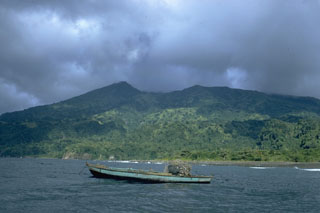Report on Soufriere St. Vincent (Saint Vincent and the Grenadines) — June 1979
Scientific Event Alert Network Bulletin, vol. 4, no. 6 (June 1979)
Managing Editor: David Squires.
Soufriere St. Vincent (Saint Vincent and the Grenadines) Aseismic lava extrusion persists; heavy rains generate large secondary mudflows
Please cite this report as:
Global Volcanism Program, 1979. Report on Soufriere St. Vincent (Saint Vincent and the Grenadines) (Squires, D., ed.). Scientific Event Alert Network Bulletin, 4:6. Smithsonian Institution. https://doi.org/10.5479/si.GVP.SEAN197906-360150
Soufriere St. Vincent
Saint Vincent and the Grenadines
13.33°N, 61.18°W; summit elev. 1220 m
All times are local (unless otherwise noted)
A period of summit crater lava extrusion, accompanied by little or no seismicity, began in late April and was continuing at the end of June.
Richard Fiske and Haraldur Sigurdsson descended into Soufrière's crater on 18 June. Lava extrusion continued from the same vent that produced the 1971 dome and the 1979 explosions. Blocky lava had flowed to the N wall of the crater, reaching maximum dimensions of 725 m across and 110 m high according to their tape and compass survey. The small number of flow front rock avalanches observed during their 4-hour stay may indicate a rate of extrusion substantially lower than in late April. Heavy steaming in the crater limited visibility.
Since the recent beginning of the rainy season, large quantities of tephra have been eroded from Soufrière's flanks. Major mud flows that traveled down the larger valleys (mostly on the W side of the volcano) carved deep, narrow canyons, dramatically exposing pre-1979 valley fill deposits. The mudflows disrupted road crossings in the Rabacca Valley (E flank) but otherwise did little property damage. Revegetation of the areas devastated by the 1979 eruption had begun by mid-June.
The zone of destruction from the 1902 eruption (N of the Wallibou and Rabacca Rivers) remains partially evacuated. Some of the several thousand evacuees work in the area during the day, but most leave at night.
Geological Summary. Soufrière St. Vincent is the northernmost and youngest volcano on St. Vincent Island. The NE rim of the 1.6-km wide summit crater is cut by a crater formed in 1812. The crater itself lies on the SW margin of a larger 2.2-km-wide caldera, which is breached widely to the SW as a result of slope failure. Frequent explosive eruptions after about 4,300 years ago produced pyroclastic deposits of the Yellow Tephra Formation, which cover much of the island. The first historical eruption took place in 1718; it and the 1812 eruption produced major explosions. Much of the northern end of the island was devastated by a major eruption in 1902 that coincided with the catastrophic Mont Pelée eruption on Martinique. A lava dome was emplaced in the summit crater in 1971 during a strictly effusive eruption, forming an island within a lake that filled the crater. A series of explosive eruptions in 1979 destroyed the 1971 dome and ejected the lake; a new dome was then built.
Information Contacts: R. Fiske, SI; H. Sigurdsson, Univ. of Rhode Island.

